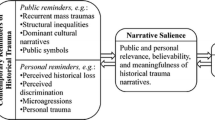Abstract
In 2007 the former federal government introduced a far-reaching ‘intervention’ into Aboriginal communities in the Northern Territory. The government claimed that the coercive measures outlined in this policy were aimed at combating child abuse and welfare dependency, arguing that ‘old approaches’ – such as self-determination – had ‘not worked’. In contrast, Sarah Maddison argues that meaningful self-determination has never in fact been tried in Australia, and is likely to be far more effective in addressing indigenous disadvantage than the overtly xenophobic and paternalistic approaches evident in the current policy approach.
Similar content being viewed by others
Notes
The three bills comprising the complex 500-page emergency response legislation were introduced to the House of Representatives on 7 August and passed that same day with bipartisan support. Following a hastily convened one-day Senate inquiry on 10 August, the legislation passed in the Upper House on 17 August without amendment. The package of legislation underpinning the intervention included the Northern Territory National Emergency Response Bill (2007); the Social Security and Other Legislation Amendment (Welfare Payment Reform) Bill (2007); and the Families, Community Services and Indigenous Affairs and Other Legislation Amendment (Northern Territory National Emergency Response and Other Measures) Bill (2007).
References
Aboriginal and Torres Strait Islander Commission (ATSIC) (1995) Recognition, Rights and Reform: A report to government on native title social justice measures, Canberra: Aboriginal and Torres Strait Islander Commission.
Australian Broadcasting Corporation (ABC) (2007) ‘Noel Pearson Discusses the Issues Faced by Indigenous Communities’, Lateline, ABC Television, 26 June.
Behrendt, Larissa (2007) ‘The Emergency we had to Have’, in Jon Altman and Melinda Hinkson (eds.) Coercive Reconciliation: Stabilise, normalise, exit Aboriginal Australia, Melbourne: Arena Publications.
Bradfield, Stuart (2006) ‘Separatism or status quo?: Indigenous affairs from the birth of land rights to the death of ATSIC’, Australian Journal of Politics and History 52 (1): 80–97.
Brennan, Sean, Larissa Behrendt, Lisa Strelein and George Williams (2005) Treaty, Sydney: The Federation Press.
Brough, Malcolm (2007) ‘National Emergency Response to Protect Children in the Northern Territory’, Media release, 21 June.
Cape York Institute (2007) From Hand Out to Hand Up: Cape York Welfare reform project, design recommendations, Cairns: Cape York Institute for Policy and Leadership.
Central Land Council (CLC) (2007) ‘From the Grassroots: Feedback from traditional landowners and community members on the Australian Government intervention’, An initial briefing paper, Central Land Council, Alice Springs, 19 December.
Cornell, Stephen (2004) ‘Indigenous Jurisdiction and Daily life: Evidence from North America’, Paper presented at the National Forum on Indigenous health and the treaty debate: Rights governance and responsibility, University of New South Wales, 11 September.
Cronin, Darryl (2007) ‘Welfare Dependency and Mutual Obligation: Negating Indigenous sovereignty’, in Aileen Moreton-Robinson (ed.) Sovereign Subjects: Indigenous sovereignty matters, Sydney: Allen & Unwin.
Doherty, Ben and Leo Shanahan (2008) ‘Review Finds Intervention Racist’, The Age, 29 October.
Fournier, Jean T. (2005) ‘Preface’, in Barbara A. Hocking (ed.) Unfinished Constitutional Business? Rethinking Indigenous Self-determination, Canberra: Aboriginal Studies Press.
Harvard Project on American Indian Economic Development (2008) The State of Native Nations: Conditions under U.S policies of self-determination, New York: Oxford University Press.
Hinkson, Melinda (2007) ‘In the Name of the Child’, in Jon Altman and Melinda Hinkson (eds.) Coercive Reconciliation: Stabilise, normalise, exit Aboriginal Australia pp 15–20, Melbourne: Arena Publications.
Hunt, Janet and Diane Smith (2007) ‘Indigenous Community Governance Project: Year 2 research findings’, Working paper No. 36/2007, Canberra: Centre for Aboriginal Economic Policy Research, Australian National University.
Maddison, Sarah (2009) Black Politics: Inside the complexity of Aboriginal political culture, Sydney: Allen & Unwin.
Moreton-Robinson, Aileen (2005) ‘Patriarchal Whiteness, Self-Determination and Indigenous Women: The invisibility of structural privilege and the visibility of oppression’, in Barbara A. Hocking (ed.) Unfinished Constitutional Business? Rethinking Indigenous Self-Determination, Canberra: Aboriginal Studies Press pp 61–73.
National Indigenous Times, (2007) ‘Heartbreak Hill’, 23 August, pp 16–18.
Pearson, Noel (2007) ‘White Guilt, Victimhood and the Quest for a Radical Centre’, Griffith Review 16: 3–58.
Ridgeway, Aden (2003) ‘Mabo Ten Years on – Small step or giant leap? in Hannah McGlade (ed.) Treaty – let's get it right!, Canberra: Aboriginal Studies Press.
Stokes, Geoffrey (2002) ‘Australian democracy and Indigenous self-determination, 1901–2001’, in Geoffrey Brennan and Francis G. Castles (eds) Australia reshaped: 200 years of institutional transformation, Cambridge: Cambridge University Press
Sutton, Peter (2001) ‘The Politics of Suffering: Indigenous policy in Australia since the 1970s’, Anthropological Forum 11 (2): 125–173.
Trudgen, Richard (2000) Why Warriors Lie Down and Die: Towards an understanding of why the Aboriginal people of Arnhem Land face the greatest crisis in health and education since European contact, Darwin: Aboriginal Resource and Development Services.
Wild, Rex and Patricia Anderson (2007) ‘Ampe Akelyernemane Meke Mekarle: Little children are sacred’, Report of the Northern Territory Board of Inquiry into the protection of children from sexual abuse, www.nt.gov.au/dcm/inquirysaac/pdf/bipacsa_final_report.pdf.
Young, Elspeth (2005) ‘Rhetoric to reality in sustainability: Meeting the challenges in Indigenous cattle station communities’ in Taylor, Luke; Graeme Ward, Graham Henderson, Richard Davis, and Lynley Wallis (eds) The power of knowledge, the resonance of tradition, Canberra: Aboriginal Studies Press.
Yu, Peter, Marcia Ella Dunca and Bill Gray (2008) ‘Report of the NTER Review Board’, http://www.nterreview.gov.au/docs/report_nter_review/default.htm.
Yunupingu, Galarrwuy (2007) ‘The challenge begins’, The Australian, 21 September.
Additional information
Underlines the importance of self-determination in policies addressing discrimination against indigenous Australians
Rights and permissions
About this article
Cite this article
Maddison, S. Australia: Indigenous autonomy matters. Development 52, 483–489 (2009). https://doi.org/10.1057/dev.2009.62
Published:
Issue Date:
DOI: https://doi.org/10.1057/dev.2009.62




